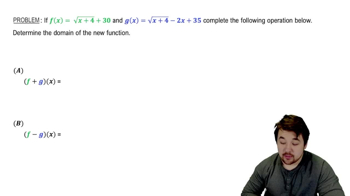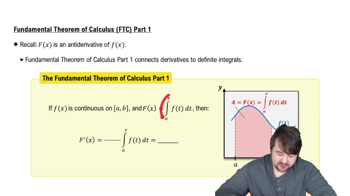Explain why the equation cos x = x has at least one solution.
Table of contents
- 0. Functions7h 54m
- Introduction to Functions16m
- Piecewise Functions10m
- Properties of Functions9m
- Common Functions1h 8m
- Transformations5m
- Combining Functions27m
- Exponent rules32m
- Exponential Functions28m
- Logarithmic Functions24m
- Properties of Logarithms36m
- Exponential & Logarithmic Equations35m
- Introduction to Trigonometric Functions38m
- Graphs of Trigonometric Functions44m
- Trigonometric Identities47m
- Inverse Trigonometric Functions48m
- 1. Limits and Continuity2h 2m
- 2. Intro to Derivatives1h 33m
- 3. Techniques of Differentiation3h 18m
- 4. Applications of Derivatives2h 38m
- 5. Graphical Applications of Derivatives6h 2m
- 6. Derivatives of Inverse, Exponential, & Logarithmic Functions2h 37m
- 7. Antiderivatives & Indefinite Integrals1h 26m
- 8. Definite Integrals4h 44m
- 9. Graphical Applications of Integrals2h 27m
- 10. Physics Applications of Integrals 3h 16m
- 11. Integrals of Inverse, Exponential, & Logarithmic Functions2h 31m
- 12. Techniques of Integration7h 41m
- 13. Intro to Differential Equations2h 55m
- 14. Sequences & Series5h 36m
- 15. Power Series2h 19m
- 16. Parametric Equations & Polar Coordinates7h 58m
1. Limits and Continuity
Continuity
Problem 2.5.63
Textbook Question
Never-zero continuous functions Is it true that a continuous function that is never zero on an interval never changes sign on that interval? Give reasons for your answer.
 Verified step by step guidance
Verified step by step guidance1
Understand the problem: We are tasked with determining whether a continuous function that is never zero on an interval can change its sign on that interval. This involves analyzing the properties of continuous functions and their behavior with respect to sign changes.
Recall the Intermediate Value Theorem (IVT): The IVT states that if a function is continuous on a closed interval \([a, b]\), and takes on two values \(f(a)\) and \(f(b)\), then it must take on every value between \(f(a)\) and \(f(b)\) at some point in the interval. This theorem is key to understanding the behavior of continuous functions.
Analyze the implications of the function being 'never zero': If a function is never zero on an interval, it means that \(f(x) \neq 0\) for all \(x\) in the interval. This implies that the function does not cross the x-axis, as crossing the x-axis would require \(f(x) = 0\) at some point.
Consider the possibility of a sign change: For a function to change sign, it must transition from positive to negative or vice versa. However, if the function is continuous and never zero, the IVT implies that it cannot cross the x-axis, which is a necessary condition for a sign change.
Conclude the reasoning: Since the function is continuous and never zero, it cannot change sign on the interval. This is because a sign change would require the function to pass through zero, which contradicts the given condition that \(f(x) \neq 0\) for all \(x\) in the interval.
 Verified video answer for a similar problem:
Verified video answer for a similar problem:This video solution was recommended by our tutors as helpful for the problem above
Video duration:
1mPlay a video:
Was this helpful?
Key Concepts
Here are the essential concepts you must grasp in order to answer the question correctly.
Continuous Functions
A continuous function is one where small changes in the input result in small changes in the output. Formally, a function f(x) is continuous at a point a if the limit of f(x) as x approaches a equals f(a). This property ensures that there are no abrupt jumps or breaks in the function's graph, which is crucial for understanding its behavior over an interval.
Recommended video:

Intro to Continuity
Sign of a Function
The sign of a function refers to whether its output values are positive, negative, or zero. A function is said to be positive on an interval if it takes only positive values and negative if it takes only negative values. Understanding the sign of a function is essential for analyzing its behavior, particularly in relation to its continuity and the implications of being never zero.
Recommended video:

Adding & Subtracting Functions Example 1
Intermediate Value Theorem
The Intermediate Value Theorem states that if a function is continuous on a closed interval [a, b] and takes on two values f(a) and f(b), then it must take on every value between f(a) and f(b) at least once. This theorem is significant in the context of the question because it implies that if a continuous function does not change sign (i.e., does not cross zero), it cannot take on both positive and negative values within that interval.
Recommended video:

Fundamental Theorem of Calculus Part 1
Related Videos
Related Practice
Textbook Question


